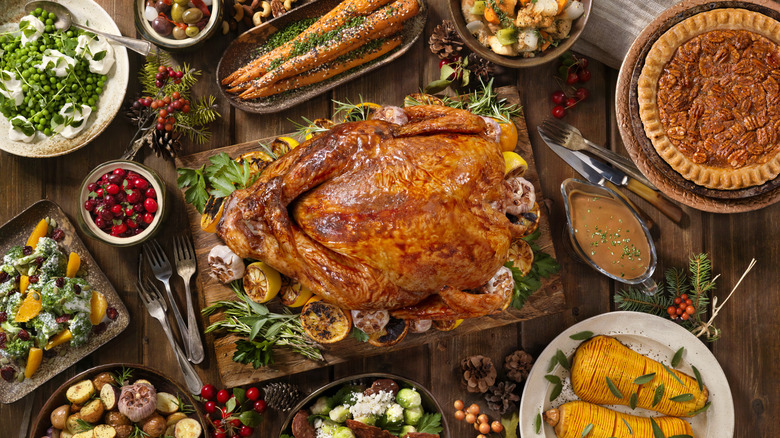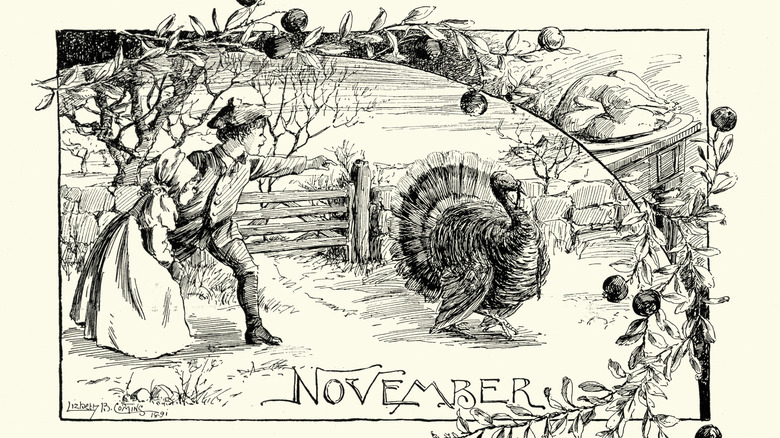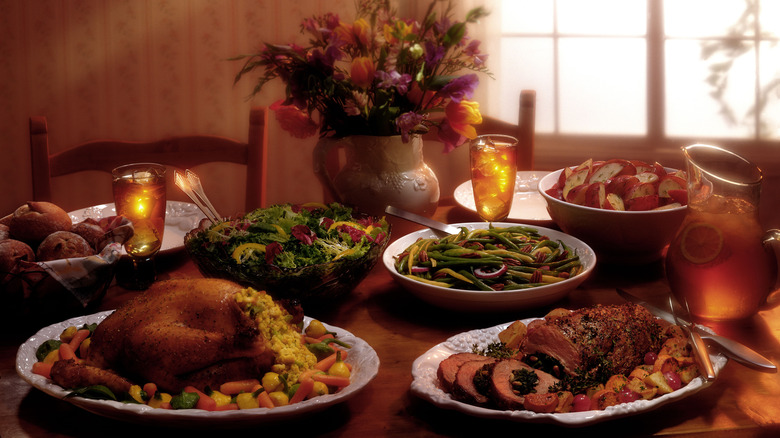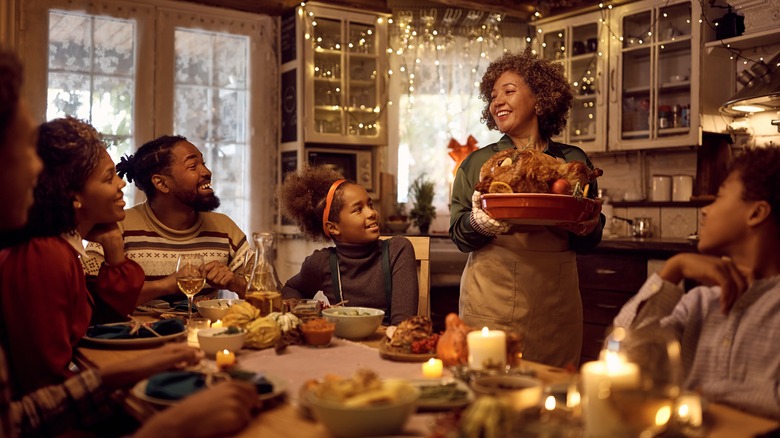What People Actually Ate At The First Thanksgiving
For many families, Thanksgiving dinners center on several core traditional dishes, such as turkey, stuffing, cranberry sauce, and mashed potatoes. Of course, meals vary by family, and also by region, but for many American families, the core foods served on Thanksgiving are sacrosanct, as iconic and essential as presents at Christmas. The holiday just isn't the same without mashed potatoes and rosemary-rich stuffing. But for a holiday so steeped in history and cultural tradition, the one thing that seems common among Thanksgiving dinners throughout history is change.
The Thanksgiving meal we now enjoy is actually quite different from the first Thanksgiving feast served in 1621. According to History Channel, the first Thanksgiving dinner was one of celebration between Puritan pilgrims and the Wampanoag people of Plymouth, Massachusetts. The feast was held as a way of giving thanks for the colony's first harvest in the 'New World.' There isn't exactly an existing menu of what foods were on the menu for the celebration. However, based on the remaining accounts of the event and knowledge of the area's agriculture at the time, we have a fair sketch as to what foods were included in the celebration.
The first Thanksgiving looked very different from today's meals
For one, turkey was most likely on the menu for the meal. However, it wasn't exactly the centerpiece of the feast as it is now, and the turkeys served would have been of the wild variety. Alongside turkey, deer and other wild birds would have also been served. Also served at the first Thanksgiving were several seafood selections, thanks to Plymouth's location close to the shoreline. Foods such as clams, oysters, mussels, and lobsters were likely served.
Unfortunately for mashed potato fans, however, potatoes were not yet being cultivated in North America at the time and therefore were not on the menu. Corn, however, was likely on the menu, as it was successfully grown at the first harvest. However, it was most likely served as a porridge rather than buttered or on the cob.
Smithsonian Magazine writes that cranberries were present at the time, as were pumpkins. But neither were served in their current, super sweet forms. And that rich, rosemary bread stuffing, was absent entirely, most likely replaced by onions, chestnuts, and other herbs, which added flavor to the wildfowl.
And though no exact menu exists for the first Thanksgiving, understanding the foods available in early American history can give us a glimpse into America's unique culinary history, which truly is something to be thankful for.
How your holiday favorites came to be
For all of its buckle hat and shoe-abundant aesthetics, Thanksgiving as we know it is actually a relatively new holiday. Though celebrated as early as the 1600s in New England as a regional holiday, Abraham Lincoln didn't declare Thanksgiving a national holiday until 1863. Since Lincon's declaration, the holiday has undergone many culinary transformations.
To start, many of your favorite Thanksgiving foods came surprisingly late to the Thanksgiving table. Recipes for cranberry sauce date back to the late 1600s, and by the time Lincoln declared Thanksgiving a holiday, the tangy treat had become such a standard offering for holiday meals that Ulysses S. Grant served it to Union troops celebrating Thanksgiving in the midst of the Civil War, according to Southern Living. Stuffing was also most likely introduced to the annual feast in the 1800s, as it has been found on several records of holiday menus at the time. Pumpkin pie was perhaps the latest to the table and didn't become widely popular until 1929 after canned pumpkin was introduced on the market.
As for the turkey, though it was likely a part of the first Thanksgiving meal, its place as the centerpiece and iconic dish of the holiday was largely due to a 19th-century campaign by author Sarah Hale to push for serving turkey as the main protein on Thanksgiving. Hale and her fellow campaigners called upon the lore of the original Thanksgiving and used the prominence of wild turkeys in colonial Massachusetts to justify their pursuit. It also didn't hurt that turkeys are a uniquely American bird, perfectly suited for a uniquely American holiday. The introduction of the turducken, on the other hand, is a bit foggier.
Bringing history to the table
Of course, just because modern Thanksgiving celebrations don't perfectly replicate recipes of yore, doesn't mean that you can't bring a little bit of history to your next Thanksgiving celebrations. It might be fun to try and incorporate some of the first Thanksgiving's more unexpected dishes into your meal.
For starters, you could serve oyster stuffing at your dinner this year, which has long been a New England classic. The incorporation of oysters recalls the first Thanksgiving's use of seafaring food while also allowing cooks to explore a traditional New England recipe that pushes the often stodgy boundaries of Thanksgiving dinner.
Another dish to try if you want to get a taste of the first Thanksgiving is chestnuts. Though the inclusion of chestnuts in the first Thanksgiving isn't written in stone, the nuts were very popular in Massachusetts at the time and continued to be popular throughout early American history and into the early 20th century. Roasting chestnuts as a treat on Thanksgiving day can prove to be a nostalgic treat that both recalls early American history and prepares you for the upcoming winter; cue Nat King Cole singing, "Chestnuts roasting on an open fireJack Frost nipping at your nose ..." You can also add chestnuts to your stuffing, as in days of yore, to give the dish a traditional twist.
Regardless of how you choose to celebrate Thanksgiving, and what you choose to serve, it's important to note that there is no right or wrong way to celebrate Thanksgiving, as long as you understand that canned cranberry sauce is an essential turkey accompaniment.



